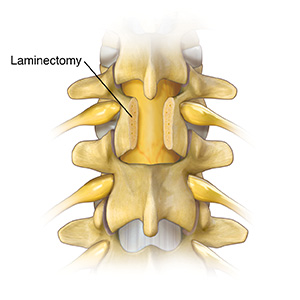Laminectomy
Vertebrae are the bones that make up the spine. Laminectomy is a surgery that removes the part of the vertebra called the lamina. This takes pressure off nerves in the low back and helps reduce symptoms. A similar surgery is called a laminotomy. For a laminotomy, only part of the lamina is removed.
A laminectomy is usually done to remove pressure from the spinal cord or the nerve roots. It can also be done to access a tumor, an infection, an abnormal blood vessel, or a blood clot. A laminectomy can be followed by a fusion of the vertebrae.
 |
| The entire lamina is removed from the affected vertebra. |
Before your surgery
Be sure to follow all of your healthcare provider's instructions on getting ready for surgery.
-
Follow any directions you're given for not eating or drinking before surgery.
-
If you take a daily medicine, ask if you should still take it the morning of surgery.
-
If you take any blood-thinning medicines, such as aspirin, discuss them with your provider at least a week before surgery.
-
At the hospital, your temperature, pulse, breathing, and blood pressure will be checked.
-
An IV (intravenous) line will be started to provide fluids and medicines needed during surgery.
During your surgery
-
Once in the operating room, you'll be given anesthesia.
-
After you are asleep, a cut (incision) is made near the center of your low back. The incision may be 2 to 6 inches long, depending on how many vertebrae are affected.
-
During a laminectomy, the lamina, or bone that forms the back of the spinal canal, is removed from the affected vertebra. The opening created may be enough to take pressure off the spinal cord or the nerve roots. If needed, your healthcare provider can also remove any bone spurs or disk matter pressing on the nerve root. After laminectomy, the opening in the spine is protected by the thick back muscles, which are closed over the bony defect.
-
Once the nerve is free of pressure, the incision is closed with stitches or surgical staples.
-
You may have 1 or 2 drains in place to help move fluid from your wound to the bulb outside your body. These tubes will be removed in the next few days.
After your surgery
After surgery, you’ll be sent to the postanesthesia care unit (PACU). When you're fully awake and stable, you’ll be moved to your room. The nurses will give you medicines to ease your pain. You may have a small tube (catheter) in your bladder. Soon, healthcare providers will help you get up and moving. You’ll also be shown how to keep your lungs clear with coughing and deep breathing exercises.
When to call your healthcare provider
Once at home, call your provider if you have any of the symptoms below:
-
Abnormal redness, heat, or fluid leaking at the incision site
-
More pain, numbness, or weakness in your leg
-
Fever over 100.4°F (38°C), or higher, or as advised by your provider
Online Medical Reviewer:
Anne Fetterman RN BSN
Online Medical Reviewer:
Heather M Trevino BSN RNC
Online Medical Reviewer:
Mahammad Juber MD
Date Last Reviewed:
4/1/2024
© 2000-2024 The StayWell Company, LLC. All rights reserved. This information is not intended as a substitute for professional medical care. Always follow your healthcare professional's instructions.